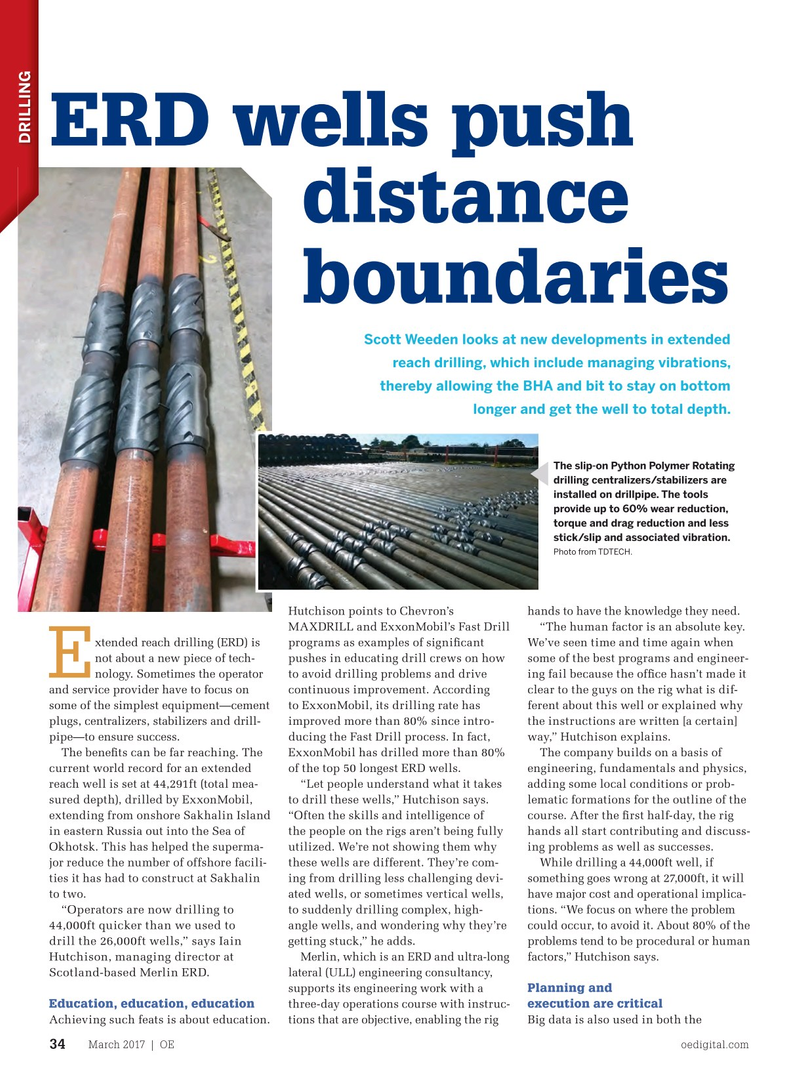
Page 32: of Offshore Engineer Magazine (Mar/Apr 2017)
Read this page in Pdf, Flash or Html5 edition of Mar/Apr 2017 Offshore Engineer Magazine
DRILLING
ERD wells push distance boundaries
Scott Weeden looks at new developments in extended reach drilling, which include managing vibrations, thereby allowing the BHA and bit to stay on bottom longer and get the well to total depth.
The slip-on Python Polymer Rotating drilling centralizers/stabilizers are installed on drillpipe. The tools provide up to 60% wear reduction, torque and drag reduction and less stick/slip and associated vibration.
Photo from TDTECH.
Hutchison points to Chevron’s hands to have the knowledge they need.
MAXDRILL and ExxonMobil’s Fast Drill “The human factor is an absolute key. programs as examples of signi? cant xtended reach drilling (ERD) is We’ve seen time and time again when pushes in educating drill crews on how not about a new piece of tech- some of the best programs and engineer-
E to avoid drilling problems and drive nology. Sometimes the operator ing fail because the of? ce hasn’t made it continuous improvement. According and service provider have to focus on clear to the guys on the rig what is dif- to ExxonMobil, its drilling rate has some of the simplest equipment—cement ferent about this well or explained why improved more than 80% since intro- plugs, centralizers, stabilizers and drill- the instructions are written [a certain] ducing the Fast Drill process. In fact, pipe—to ensure success. way,” Hutchison explains.
ExxonMobil has drilled more than 80% The bene? ts can be far reaching. The The company builds on a basis of of the top 50 longest ERD wells. current world record for an extended engineering, fundamentals and physics, “Let people understand what it takes reach well is set at 44,291ft (total mea- adding some local conditions or prob- to drill these wells,” Hutchison says. sured depth), drilled by ExxonMobil, lematic formations for the outline of the “Often the skills and intelligence of extending from onshore Sakhalin Island course. After the ? rst half-day, the rig the people on the rigs aren’t being fully in eastern Russia out into the Sea of hands all start contributing and discuss- utilized. We’re not showing them why Okhotsk. This has helped the superma- ing problems as well as successes.
these wells are different. They’re com- jor reduce the number of offshore facili- While drilling a 44,000ft well, if ing from drilling less challenging devi- ties it has had to construct at Sakhalin something goes wrong at 27,000ft, it will ated wells, or sometimes vertical wells, to two. have major cost and operational implica- “Operators are now drilling to to suddenly drilling complex, high- tions. “We focus on where the problem 44,000ft quicker than we used to angle wells, and wondering why they’re could occur, to avoid it. About 80% of the drill the 26,000ft wells,” says Iain getting stuck,” he adds. problems tend to be procedural or human
Merlin, which is an ERD and ultra-long
Hutchison, managing director at factors,” Hutchison says.
lateral (ULL) engineering consultancy,
Scotland-based Merlin ERD.
Planning and supports its engineering work with a
Education, education, education execution are critical three-day operations course with instruc-
Achieving such feats is about education. Big data is also used in both the tions that are objective, enabling the rig
March 2017 | OE oedigital.com 34 034_OE0317_Drilling1_Scott.indd 34 2/21/17 7:00 PM

 31
31

 33
33